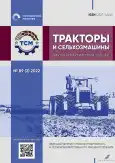Experimental assessment of the temperature state of tractor diesel pistons
- Authors: Belov V.P.1, Apelinskiy D.V.1, Bezhenar V.N.1
-
Affiliations:
- Moscow Polytechnic University
- Issue: Vol 89, No 2 (2022)
- Pages: 111-120
- Section: Theory, designing, testing
- URL: https://journals.rcsi.science/0321-4443/article/view/105717
- DOI: https://doi.org/10.17816/0321-4443-105717
- ID: 105717
Cite item
Full Text
Abstract
INTRODUCTION: The paper presents the operating conditions of tractor diesel engines that cause the appearance of thermal fatigue cracks on the edges of the piston combustion chamber. The presence of sharp edges of the combustion chamber in the pistons, which are stress concentrators, leads to an increase in the probability of their destruction and thereby limits the engine life of the diesel engine. The main reasons for the formation of cracks in the zone of the edge of the combustion chamber are indicated.
AIMS: The aim of this study is the assessment of the temperature state of pistons of the D-240 and the D-245 tractor diesel engines, produced by Minsk Motor Plant (MMP).
METHODS: Temperature gauging was carried out according to the method in order to identify the nature of changing of piston heads temperatures under stationary and nonstationary operation modes of diesel engines. Transfering of thermal electromotive force from thermocouples to measuring devices was carried out by means of an intermittent current collector. Imitaion of nonstationary operation modes was carried out by means of changing the cyclic feed of a high pressure fuel pump, using a reversible electric motor.
RESULTS: The data of the temperature state of pistons under various stationary and nonstationary operation modes of engines is provided. It is noted that the temperature state of the D-245 diesel pistons has a higher level of heat stress compared to the D-240 diesel pistons. The maximum amplitude of low-frequency temperature fluctuations at the edge of the combustion chamber and their radial differences along the piston bottom are determined, depending on the parameters of thermal loading cycles. It is noted that the most dangerous modes of diesel operation, in terms of the destruction of the edge of the combustion chamber, are sharply changing modes (eg.: the“loading – unloading” mode).
CONCLUSIONS: It is proposed to increase the fuel injection advance angle in the thermal loading cycle in order to conduct accelerated comparative tests of piston variants for thermal resistance. The developed thermal loading cycle, in which the total duration of the load increase is 180 s and the total duration of the load decrease is 90 s, can be recommended for accelerated motor tests of pistons for thermal cycling resistance. The obtained temperature measurement data is recommended to clarify boundary conditions of the first kind when calculating the piston using the FEM method.
Full Text
##article.viewOnOriginalSite##About the authors
Vyacheslav P. Belov
Moscow Polytechnic University
Email: belovmami@mail.ru
ORCID iD: 0000-0002-2031-669X
SPIN-code: 9146-3300
Cand. Sci. (Engin.), Professor of the Power Plants for Transport and Small Energy Department
Russian Federation, 38 Bolshaya Semyonovskaya str., Moscow, 107023Dmitry V. Apelinskiy
Moscow Polytechnic University
Email: apelinskiy_mami@mail.ru
ORCID iD: 0000-0003-2841-6895
SPIN-code: 2311-0480
Associate Professor, Cand. Sci. (Engin.), Associate Professor of the Power Plants for Transport and Small Energy Department
Russian Federation, 38 Bolshaya Semyonovskaya str., Moscow, 107023Vadim N. Bezhenar
Moscow Polytechnic University
Author for correspondence.
Email: amadei.96@mail.ru
ORCID iD: 0000-0003-3747-2530
SPIN-code: 1733-6826
Head of the Laboratory of the Power Plants for Transport and Small Energy Department
Russian Federation, 38 Bolshaya Semyonovskaya str., Moscow, 107023References
- Belov VP, Apelinskii DV. Calculation and experimental method for assessing the thermal cyclic resistance of forced diesel pistons. Izvestiya MGTU MAMI. 2020;(1):8–17. (In Russ).
- Belov VP. Raschetno-eksperimental'naya otsenka termostoikosti porshnei forsirovannykh avtomobil'nykh i traktornykh dvigatelei. [dissertation]. Moscow; 1986. Available from: https://www.dissercat.com/content/issledovanie-i-prognozirovanie-dolgovechnosti-porshnei-dvigatelei-vnutrennego-sgoraniya (In Russ).
- Glinkin SA. Issledovanie i prognozirovanie dolgovechnosti porshnei dvigatelei vnutrennego sgoraniya. [dissertation]. Vladimir; 2010. Available from: https://www.dissercat.com/content/issledovanie-teplovoi-napryazhennosti-klapanov-avtomobilnykh-benzinovykh-dvigatelei-s-primen (In Russ).
- Zhegalin ON, Lunachev PD. Veroyatnostnaya otsenka rezhimov raboty traktornogo dvigatelya. Traktory i sel'khozmashiny. 1985;(9):6–7. (In Russ).
- Ivanchenko AB. Metodika otsenki termoustalostnoi prochnosti porshnei forsirovannykh dizelei. [dissertation]. Moscow; 1995. (In Russ).
- Kazantsev AG. Malotsiklovaya ustalost' pri slozhnom termomekhanicheskom nagruzhenii. Moscow: MGTU im. N.E. Baumana; 2001. (In Russ).
- Kramarukhin YuE. Pribory dlya izmereniya temperatury. Moscow: Mashinostroenie; 1990. (In Russ).
- Lazarev EA, Ivashchenko NA, Perlov ML. Osobennosti teplovogo i napryazhenno-deformirovannogo sostoyaniya porshnei traktornogo dizelya. Dvigatelestroenie. 1988;(7):3–5. (In Russ).
- Lizunov AA. Termostoikost' porshnei avtomobil'nykh i traktornykh dizelei pri nestatsionarnykh rezhimakh raboty. [dissertation]. Moscow; 1988. (In Russ).
- Chainov ND, Timokhin AV, Ivanchenko AB. Otsenka ustalostnoi dolgovechnosti porshnya traktornogo dizelya pri tsiklicheskom nagruzhenii. Dvigatelestroenie. 1991;(11):14–15. (In Russ).
- Patent SU № 1012066/ 15.04.83, Byul. № 14. Radzivan AS, Belov VL, Repin VV, et al. Stend dlya issledovaniya teplonapryazhennogo sostoyaniya porshnya dvigatelya vnutrennego sgoraniya. Available from: https://patentdb.ru/patent/1196721 (In Russ).
- Belov VP, Apelinskiy DV. Computational and Experimental Method for Assessing the Thermal Strength of High-Loaded Diesel Engines. Journal of Physics: Conference Series. 2021;2096(1). doi: 10.1088/1742-6596/2096/1/012204
Supplementary files















